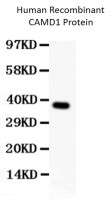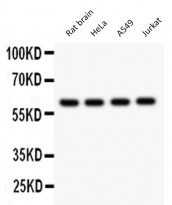ARG59673
anti-CAMD1 antibody
anti-CAMD1 antibody for Western blot and Human,Rat
Overview
| Product Description | Rabbit Polyclonal antibody recognizes CAMD1 |
|---|---|
| Tested Reactivity | Hu, Rat |
| Predict Reactivity | Bov, Hrs, Mk, Rb |
| Tested Application | WB |
| Host | Rabbit |
| Clonality | Polyclonal |
| Isotype | IgG |
| Target Name | CAMD1 |
| Antigen Species | Human |
| Immunogen | Recombinant protein corresponding to Q45-P340 of Human CAMD1. |
| Conjugation | Un-conjugated |
| Alternate Names | NECL2; IGSF4; Necl-2; RA175; Spermatogenic immunoglobulin superfamily; synCAM1; IGSF4A; sgIGSF; Immunoglobulin superfamily member 4; IgSF4; NECL-2; sTSLC-1; Tumor suppressor in lung cancer 1; BL2; TSLC1; SynCAM; SYNCAM; SgIgSF; ST17; Nectin-like protein 2; Cell adhesion molecule 1; TSLC-1; Synaptic cell adhesion molecule |
Application Instructions
| Application Suggestion |
|
||||
|---|---|---|---|---|---|
| Application Note | * The dilutions indicate recommended starting dilutions and the optimal dilutions or concentrations should be determined by the scientist. |
Properties
| Form | Liquid |
|---|---|
| Purification | Affinity purification with immunogen. |
| Buffer | 0.9% NaCl, 0.2% Na2HPO4, 0.05% Sodium azide and 5% BSA. |
| Preservative | 0.05% Sodium azide |
| Stabilizer | 5% BSA |
| Concentration | 0.5 mg/ml |
| Storage Instruction | For continuous use, store undiluted antibody at 2-8°C for up to a week. For long-term storage, aliquot and store at -20°C or below. Storage in frost free freezers is not recommended. Avoid repeated freeze/thaw cycles. Suggest spin the vial prior to opening. The antibody solution should be gently mixed before use. |
| Note | For laboratory research only, not for drug, diagnostic or other use. |
Bioinformation
| Database Links | |
|---|---|
| Gene Symbol | CADM1 |
| Gene Full Name | cell adhesion molecule 1 |
| Function | Mediates homophilic cell-cell adhesion in a Ca(2+)-independent manner. Also mediates heterophilic cell-cell adhesion with CADM3 and PVRL3 in a Ca(2+)-independent manner. Acts as a tumor suppressor in non-small-cell lung cancer (NSCLC) cells. Interaction with CRTAM promotes natural killer (NK) cell cytotoxicity and interferon-gamma (IFN-gamma) secretion by CD8+ cells in vitro as well as NK cell-mediated rejection of tumors expressing CADM3 in vivo. May contribute to the less invasive phenotypes of lepidic growth tumor cells. In mast cells, may mediate attachment to and promote communication with nerves. CADM1, together with MITF, is essential for development and survival of mast cells in vivo. Acts as a synaptic cell adhesion molecule and plays a role in the formation of dendritic spines and in synapse assembly (By similarity). May be involved in neuronal migration, axon growth, pathfinding, and fasciculation on the axons of differentiating neurons. May play diverse roles in the spermatogenesis including in the adhesion of spermatocytes and spermatids to Sertoli cells and for their normal differentiation into mature spermatozoa. [UniProt] |
| Cellular Localization | Cell membrane; Single-pass type I membrane protein. Cell junction, synapse. Note=Localized to the basolateral plasma membrane of epithelial cells in gall bladder. [UniProt] |
| Calculated MW | 49 kDa |
| PTM | Glycosylation at Asn-67 and Asn-101 promotes adhesive binding and synapse induction. [UniProt] |
Images (2) Click the Picture to Zoom In
-
ARG59673 anti-CAMD1 antibody WB image
Western blot: 0.5 ng of Human Recombinant CAMD1 Protein stained with ARG59673 anti-CAMD1 antibody at 0.5 µg/ml dilution.
-
ARG59673 anti-CAMD1 antibody WB image
Western blot: 50 µg of Rat brain, 40 µg of HeLa, 40 µg of A549 and 40 µg of Jurkat whole cell lysates stained with ARG59673 anti-CAMD1 antibody at 0.5 µg/ml dilution.







